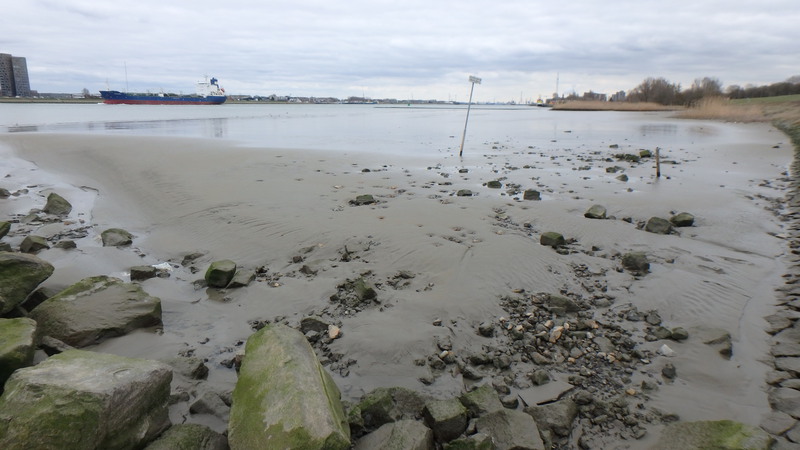Rotterdam project puts sediment back where it needs to be

Caption: Clean dredged sediment reused at the estuary reach at the Nieuwe Waterweg (New Waterway), close to Port of Rotterdam, to create an intertidal nature reserve. Photo Credit: Kees Sloff
A project trialling dredged sediment reuse to mitigate against erosion and increase flood protection on the Rhine-Meuse river estuary near Rotterdam began in March.
Every year 15 to 20 million m3 of sediment is dredged from the port to maintain berth and approach channel depths, and much of this sand and mud is relocated to the nearby North Sea. Whilst a build-up of sediment around the port is undesirable for ship navigation, more sediment is needed in other locations in the estuary.
According to Kees Sloff, a specialist in river engineering and fluvial morphology with Deltares and Marco Wensveen, asset management constructions and dredging, from Rotterdam Port Authority, additional sediment is vital for redevelopment of intertidal areas, filling scour holes on the riverbed, improving stability of banks and dikes for flood safety, and in the re-creation of natural habitats that have disappeared over time.
The four-year Rijnmond Sediment Field Trial is a practical research project that aims to identify different sediment-based solutions to address these issues in the Rijnmond (River Rhine mouth) area. Rotterdam Port Authority and Deltares are two of the nine partners involved the project.
Sloff told CEDA Industry News he hopes the research will “find ways to get clean sediment back in the river’s ecosystem” and to keep it there for as long as possible, “to enhance nature and safety”.
One example of how dredged sediment can potentially support the area is through the recreation of tidal areas. Barrier systems installed in the estuary have reduced tidal movement and so certain locations that should silt up, no longer do. This in turn affects the region’s ecology.
“It’s hoped that the project will result in innovative ways to distribute different sediment types to sites where it’s needed and not out at sea,” he said.
“We need to find ways to get clean sediment to the required locations,” he added, noting that if it’s not quite the right type of sediment for a certain location it can be mixed with other materials so that it’s fit for purpose.
Another potential use for sediment is to fill scour holes in the riverbed created by current or wave activity. These holes can become a safety hazard as they reduce bank and dike stability. In a Deltares statement, Sloff said: “We want to find out if there’s a smart way of combining the filling of the scour holes with a method similar to the one used for the Sand Motor to prevent the river causing further erosion. We also want to know how the sand moves, whether it would hinder shipping and what the consequences for wildlife would be. So, we’re going to monitor all of that.”
The practical approach to this research is seen as integral to its success. “You can’t learn everything from computer modelling” he told CEDA Industry News. “Models don’t know everything. But you can learn from ‘doing’ in the field and improve the models”.
Three different locations will be selected in the Rijnmond area, each with different characteristics and requirements, explained Sloff. The three sites, which will be selected from a shortlist of seven, will all have maintenance or projects planned.
Marco Wensveen, asset management constructions and dredging, from Rotterdam Port Authority told CEDA Industry News that the resultant research will help reduce maintenance requirements in the short term, and in the long term, reduce the negative impacts of sea-level rise”.
The project’s findings will have universal scope he said and should be suitable for application at most delta areas around the world. “In four years we will have a range of results,” he said. “We hope these results will feed into scientific and technology papers,” and could “affect the way we process sediment”.
Other organisations involved in the project are: The Netherlands’ Rijkswaterstaat (Ministry of Infrastructure and Water Management), World Wildlife Fund with ARK Nature, Dutch conservation organisation Natuurmonumenten, Waterboard Hollandse Delta, Wageningen Marine Research, and De Vries & van de Wiel Dredging.”
While the advice given in this editorial content has been developed using the best information available, it is intended purely as guidance to be used at the user’s own risk. No responsibility is accepted by CEDA or by the Intent Communications Ltd or by any person, firm, corporation or organisation who or which has been in any way concerned with the furnishing of information or data, the compilation, publication or any translation, supply or sale of this Guidance for the accuracy of any information or advice given herein or for any omission herefrom or from any consequences whatsoever resulting directly or indirectly from compliance with or adoption of guidance contained therein even if caused by a failure to exercise reasonable care.